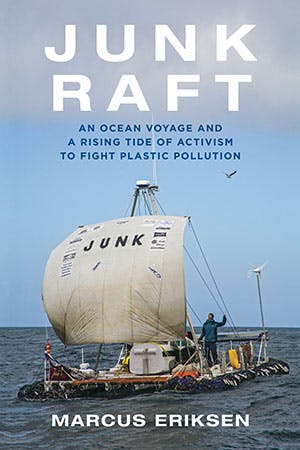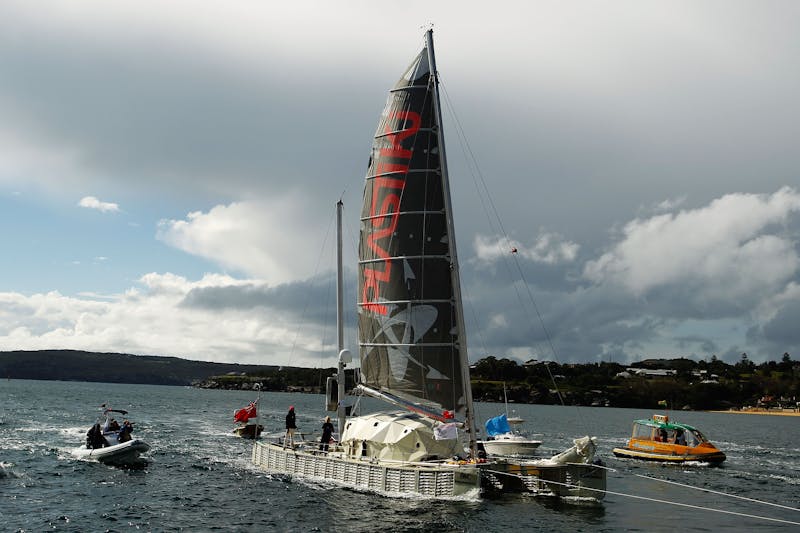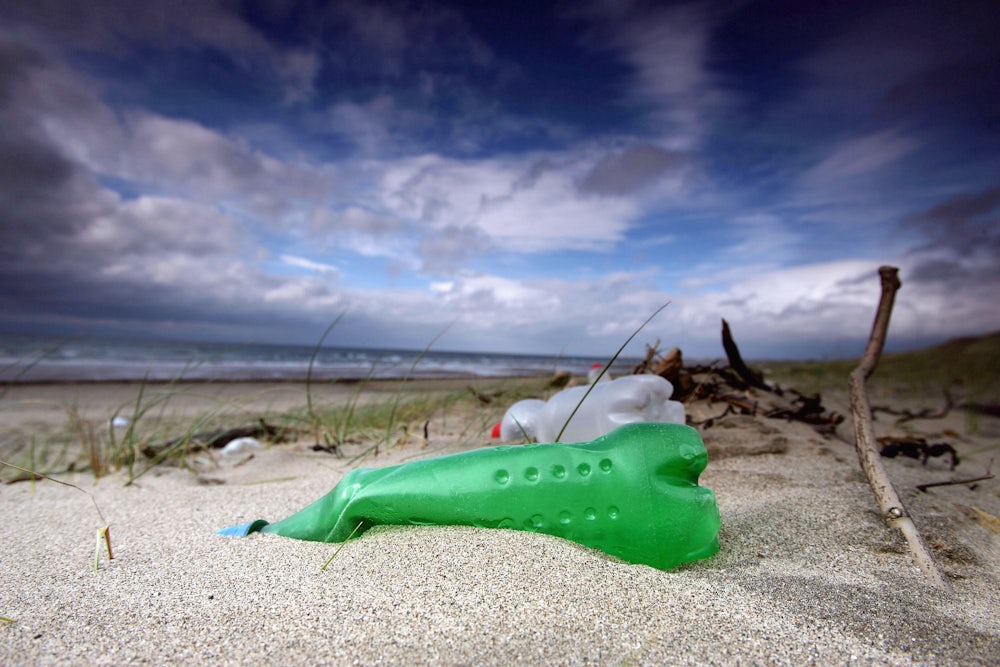In the summer of 1997, sea captain and surfer Charles Moore was sailing home from Hawaii. He’d been recently finished the TransPacific Yacht Race, and on the way back to California, he decided to take a shortcut. Instead of following the current that swoops along the edge of the North Pacific subtropical gyre, he set a course through the still waters of the high-pressure zone at its center. “1997 was the largest El Niño on record,” he recalled years later. “It had the warmest surface water in the Pacific,” which made the waters extremely smooth and calm. As Moore passed through, he noticed something: trash—specifically plastic trash—all around. This remote part of the ocean was, he told Stephen Colbert in 2010, “a disgusting plastic cesspool.”

News of Moore’s discovery quickly took on a life of its own. The swirl of debris came to be known variously as the great Pacific garbage patch, the Pacific trash vortex and the island of floating trash. It was a colorful symbol of an often overlooked problem. Global warming had its starving polar bear; now, ocean pollution had its Frankenstein trash island. By 2012, one particular image of the patch attached to much of the coverage. It showed a stretch of ocean completely clogged with brightly colored plastic flotsam. Only after looking at the image for a while could you notice the man in a boat in the center of the frame, a Where’s Waldo stranded in a scene of environmental catastrophe.
But that picture wasn’t taken at the garbage patch. It was taken near the shore in the Bay of Manila. The plastic pollution in the gyre is far less visible. “It wasn’t like an island of trash like people keep wanting to say,” Moore clarified in an interview with Earth Island Journal. “It’s just that I couldn’t survey the surface of the ocean for any period of time while standing on deck without seeing some anthropogenic debris float by.” A new book on ocean plastics, Junk Raft, by Marcus Eriksen, sifts through the myth of the gyre and explains that while the image of a hulking trash island is false, what’s there instead is even more worrisome. Part memoir, part clean-ocean manifesto, Junk Raft tells the story of Eriksen’s own visit to the gyre, travelling on a raft made of throwaway plastics. “There’s no island, no garbage patch,” Eriksen writes of what he finds when he arrives. “This was much worse.”
Instead of a trash island, Eriksen and his sailing partner Joel Paschal find an ocean full of plastic fragments. Battered by the ocean and degraded by the sun, the plastics that make it all the way to the gyre are, for the most part, not whole objects, but little shreds and particles. Some of these float at the surface of the water, where they attract fish and seabirds in search of food. Eriksen wants to replace the old and inaccurate images of the garbage island, which, he writes, “don’t capture the distribution, toxicity, or widespread harm to marine life.” Instead, we should think of the plastic in the ocean as a kind of smog: swirls of particulate matter surrounding the creatures who live and breathe and eat underwater. “Imagine if you could stand on the ocean floor and look up and see only the plastic,” he explains:
You would see five massive clouds of microplastic in the subtropical gyre and dark clouds of larger plastic pieces coming from the world’s largest rivers and densely populated coastlines… All around you would be a mist of dust-like microplastic fragments settling to the seafloor.
Traveling by raft, Eriksen and Paschal make their way into the gyre the way that plastic garbage does—passively carried along by the current. Along the way the pair run up against storms, boat trouble, gastrointestinal distress. Eriksen describes, too, the rise of plastics and plastic pollution, the chemistry that makes these materials so persistent and pernicious, and the lengths that the industry has gone to in order to to dodge responsibility for safely disposing of the plastics it creates. By the time we reach the gyre, plastics—especially those items designed to be immediately disposed of—seem to be not just the source of an ecological problem but inherently sinister.
Plastics didn’t start out with a bad reputation. In 1955, Life magazine published a celebratory article on disposable plastics, titled “Throwaway Living” and accompanied by an image of a family beaming amid a cascade of plastic plates, buckets, and forks. Nobody would ever need to do dishes again. As Susan Freinkel writes in her 2011 book Plastic: A Toxic Love Story, when these single-use products arrived on the market just after World War II, they were anathema to people who, having lived through the Depression and wartime scarcity, had deeply internalized “the ethos of reuse.” These consumers habitually reused anything they bought until it was worn out, writes Freinkel. “They had to learn—and be taught—to throw away.”
The first plastics were developed to replace diminishing supplies of natural materials like ivory, bone, wood, and tortoise-shell. In the 1860s, the New York Times reported on the demise of elephants, who were being driven to extinction by humanity’s insatiable demand for ivory to make combs, piano keys, and billiard balls. Malleable, versatile celluloid—a polymer made from the cellulose in cotton—was first developed in 1869 with the goal of making an elephant-free billiard ball. And slick, shiny Bakelite was developed in 1907 to replace shellac, a material important to the electrical industry but oddly produced; shellac was made from the excretions of a beetle, and it took 15,000 beetles six months to produce a pound of the stuff. These new compounds let the world’s beetles and elephants off the hook, and with the rationing of natural rubber during World War II, the new synthetics really took hold.
Plastics heralded a new era of total material freedom. Instead of the careful rationing of the Depression and wartime, goods could now be cheaply produced, as if by magic, from materials whipped up in the lab. In the early twentieth century, plastics and fossil fuels rose together, with the byproducts of oil and natural gas refining processes being used as the raw material for plastic production. Freinkel recounts an apocryphal story of John D. Rockefeller looking out over his oil refineries and seeing a flame shoot up through a smokestack. He asked what was burning and someone explained that it was ethylene gas, a byproduct of the refining process. Loathe to waste, Rockefeller told him to “Find something else to do with it!” Ethylene gas became the main ingredient in polyethylene, a common plastic used in bags, bottles, and other packaging. It’s estimated that next year global production of polyethylene alone will reach 100 million tons.
Eriksen is dedicated to following those bags and bottles all the way to the end of their life cycle. He travels to a landfill in Delhi, a recycling center in Marin County, a Dubai veterinary clinic. Along the way he recounts tales of landscapes and creatures that have met with gruesome ends because of plastics. Camels starve with their bellies clogged full of plastic bags they’ve eaten. Plastics that mimick estrogen turn a beluga whale into a hermaphrodite. Sea turtles with plastic particles in their bloodstream lay fewer and fewer eggs. At one point, as Eriksen and Paschal run low on food brought from land, they fish off the side of the raft. They catch some rainbow runners, and quickly filet them on the deck—but before they can dig in, Eriksen notices something off about one of their catch. “The stomach, roughly the size of an almond, feels hard… I touch it with the edge of the filet knife and it splits open. Seventeen fragments of plastic pour out. There’s nothing else inside.”
More compelling than these anecdotes, though, are the sections in which Eriksen guides readers to think critically about our culture of consumption and disposal. In a world of cheap products and planned obsolescence, many of the things we buy are intended to be thrown away. The question is: “where is away?” All the cheap convenient items (and the cheap convenient wrappers they come in), Eriksen points out, have to go somewhere. Less than 10 per cent of discarded plastics are recycled—the rest head to landfills. Plastics that get tossed by the side of the road, or wind up in poorly-managed landfills, can be swept into storm drains and rivers, and eventually out to the ocean.
To prevent the build-up of still more waste, Eriksen argues for a “circular economy”—one in which products are designed for a long life and reuse. “In the circular economy,” he outlines,
materials come back to the manufacturer through a revised value chain that creates economic incentives, or policy incentives. Putting product designers, systems engineers, and recyclers in the same room in tandem is how we close the loop.
He’s suggesting a giant shift in paradigm: that an industry’s responsibility for the goods it produces doesn’t end the moment a consumer takes that item home.
Perhaps the most revelatory sections are Eriksen’s book are those that trace the history that made consumer choice the center of gravity of American environmentalism. He recalls the “Crying Indian” ad campaign of the 1970s, in which the Italian-American actor Iron Eyes Cody portrayed a Native American man tearing up at the sight of litter along a highway. The ad campaign was created by the organization Keep America Beautiful and funded by companies including Anheuser-Busch, PepsiCo, and Coca-Cola. It “put the blame for plastic pollution on the consumer.” This message—that individuals should bear full responsibility for disposal and municipalities should bear the cost—directly benefitted the products’ manufacturers. “The strategy,” he writes, “deflected attention away from producer responsibility and product design, and we bought it hook, line, and sinker.”
It doesn’t have to be this way. Eriksen argues for extended producer responsibility laws (EPRs). This isn’t making an unreasonable demand on producers. Of the 35 members of the OECD, the United States is the only nation that doesn’t have such a law for plastic packaging. In fact, it could be good for businesses. “When a company is responsible for the full life-cycle of its product and its packaging,” Eriksen finds, “innovation for recovery catches on like wildfire.”
The battles to pass such laws are currently underway. Last year California “banned” single-use plastic bags in grocers and convenience stores (bags aren’t really banned, but customers who want a bag from the shop pay 10 cents for a paper or reusable one). And microbeads—tiny pieces of plastic that are supposed to aid in scrubbing—are banned from rinse-off products like cleansers and toothpaste as of this summer. Each of these developments has been contentious, but they signal a shift in thinking about the effects of waste, and indicate that we might start to expect companies to take responsibility for the harmful materials they produce and profit from.
Eriksen returns often to his own life story. His writing is most beautiful when describing the ocean itself. “Thousands of collisions formed trails of light that poured off my fingertips,” he writes of a dive among bioluminescent plankton, “an astronaut among living stars.” In brief anecdotes, we learn about his relationship with his wife (he proposed to her on a boat and followed his question immediately with, “There’s just one thing—I want to raft across the ocean”) and his time in the army. He recounts his return in 2015 to Kuwait, where he was deployed in the first Gulf War, and reckons with some of his own actions as well as effects of global military-petroleum complex.

It’s fitting that this book insists on cloaking its political and polemical content in the more palatable shape of a personal narrative. That’s exactly what Eriksen was doing on his voyage to the gyre—providing a story he could use to raise awareness around the issue of plastic pollution. At one point when the raft seems in danger of coming apart, Eriksen is as worried about saving the narrative as he is about saving his own skin. “We need a good story to rally the public around,” he writes, “and this adventure is the entry point.”
He’s not the only one to place this kind of value on a publicity stunt in the service of an environmental issue—or even this environmental issue, for that matter. David de Rothschild sailed a catamaran made of 12,000 plastic bottles from California to Australia in 2010, also to raise awareness of plastic pollution in the ocean. (Eriksen writes briefly about the de Rothschild voyage—the pair briefly squabbled over who would get to name their vessel “Plastiki,” a nod to the Kon Tiki, the name of a raft that explorer Thor Heyerdahl used to cross the Pacific in 1947.) Perhaps they’re right to do so, and the stunt or the story really does push an issue into the right current, leading to public interest and on to actual reform.
But ultimately it’s the analytic, prescriptive parts of Junk Raft that give the book its thrust, while the personal stories bob along the surface. Like the rumors of the flashy floating trash island versus the sober, but less photogenic reality of microplastic smog, it’s not always the flashiest element that most deserves attention.
